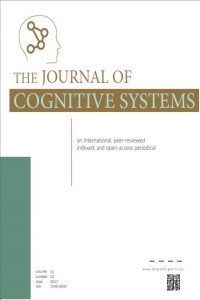Abstract
References
- http://www.koeri.boun.edu.tr/sismo/Personel/comoglu/depremnedir ,07/07/2017
- Bayındırlık Ve İskan Bakanlığı Deprem Şurası Sonuç Bildirgesi, İstanbul, 1 Ekim 2004
- F. Özçep, M. Aşçı, N. Alpaslan, T. Yas, D. Gündoğdu, "Statik Ve Dinamik (Deprem) Etkiler Altında Zemin Davranışı", Deprem Sempozyumu, Kocaeli, 2005.
- Düzce Organize Sanayi Bölgesi Revizyon İmar Planı 1/5000 – 1/1000 Açıklama Raporu, 2017
- http://yerbilimleri.mta.gov.tr/anasayfa.aspx, 07.11.2017
- http://www.qgis.org/tr/site, 07.11.2017.
- http://udim.koeri.boun.edu.tr/zeqdb, 07.11.2017
- https://www.mathworks.com/help/fuzzy/fuzzylogicdesignerapp.html?requestedDomain=www.mathworks.com , 07/07/2017.
- S. Uzun, H. Kazan, “Çok Kriterli Karar Verme Yöntemlerinden AHP TOPSIS ve PROMETHEE Karşılaştırılması: Gemi İnşada Ana Makine Seçimi Uygulaması”, Journal of Transportation and Logistics, 2016
- http://debis.deu.edu.tr/userweb/k.yaralioglu/dosyalar/ Analitik_Hiyerarsi_Proses.doc, 05.07.2017
- F. Bozyiğit, D. Kılınç, A. Kut, M. Kaya, “Bulanık Mantık Algoritmaları Kullanarak Kaynak Kod Benzerliği Bulma”, XVII. Akademik Bilişim Konferansı – Ab, 2015
- M. Yılmaz, E. Arslan, "Bulanık Mantığın Jeodezik Problemlerin Çözümünde Kullanılması", Harita ve Kadastro Mühendisleri Odası, Mühendislik Ölçmeleri STB Komisyonu 2. Mühendislik Ölçmeleri Sempozyumu, 23-25 Kasım 2005, İTÜ – İstanbul
- M.A. Derinpınar, A. Ç. Aydınoğlu, "Bulanık Mantık ile Coğrafi Bilgi Teknolojilerini Kullanarak Taşınmaz Değerlemesi", TMMOB Harita ve Kadastro Mühendisleri Odası, 15. Türkiye Harita Bilimsel ve Teknik Kurultayı, 2528 Mart 2015, Ankara
- C. Şenol, T. Yıldırım, "Bulanık-Sinir Ağı Yapısı İçin Yeni Bir Karma Yaklaşım", http://www.emo.org.tr/ekler/2d3d18a536479e3_ek.pdf
- İ. Y. Kazu , O. Özdemir, “Öğrencilerin Bireysel Özelliklerinin Yapay Zeka ile Belirlenmesi (Bulanık Mantık Örneği)", Akademik Bilişim 09 - XI. Akademik Bilişim Konferansı Bildirileri 11-13 Şubat 2009 Harran Üniversitesi, Şanlıurfa
- B. Gültekin, S. Biroğul, İ. Yücedağ, "İşe Alım Süreci Aday Ön Tesbitinde Bulanık Mantık Tabanlı SQL Sorgulama Yönteminin İncelenmesi", Düzce Üniversitesi Bilim ve Teknoloji Dergisi, 3 (2015) 198-209
- M. E. Bayrakdar, S. Bayrakdar, İ. Yücedağ, A. Çalhan, "Bilişsel Radyo Kullanıcıları için Bulanık Mantık Yardımıyla Kanal Kullanım Olasılığı Hesabında Farklı Bir Yaklaşım", Düzce Üniversitesi Bilim ve Teknoloji Dergisi, 3 (2015) 88-99
- M. Ş. Biçen,, A. Çalhan, İ. Yücedağ , "Kablosuz Heterojen Algılayıcı Ağlarda Bulanık Mantık Tabanlı Ağ Geçidi Seçimi", Düzce Üniversitesi Bilim ve Teknoloji Dergisi, 4 (2016) 655-660
Abstract
Earthquake hazard is defined as the determination of a ground motion from a large earthquake that can cause damage and loss in a certain place and within a certain time period. Damage due to an earthquake is an important element of the earthquake risk concept, which is defined as the probability of loss of property and life. There are many variables that constitute the earthquake hazard. The number and type of these variables may vary in different studies and for different purposes. In this study; geology of the city, lengths of active faults and the epicenter of the earthquake outer-center points of the earthquakes with a magnitude greater than 3 on between 1905 and 2016 were used. In this study; Open Source Code Geographic Information Systems (GIS) Software QGIS, Analytical Hierarchy Process (AHP) and Fuzzy Logic Method have been used to investigate the earthquake hazard of Düzce districts. These parameters were evaluated together to create thematic maps. Regions were determined in terms of earthquake hazard in the generated maps. As a result of the analysis by two methods, the districts showed similar results in terms of earthquake hazard. According to the three criteria evaluated, the central district is the most risky district with 39%. Yigilca, Gölyaka and Kaynaslı districts are medium risky districts. Cilimli, Gümüsova, Cumayeri and Akcakoca are the least risky districts.
Keywords
Düzce earthquake hazard analysis AHP fuzzy logic open source code geographic information systems QGIS
References
- http://www.koeri.boun.edu.tr/sismo/Personel/comoglu/depremnedir ,07/07/2017
- Bayındırlık Ve İskan Bakanlığı Deprem Şurası Sonuç Bildirgesi, İstanbul, 1 Ekim 2004
- F. Özçep, M. Aşçı, N. Alpaslan, T. Yas, D. Gündoğdu, "Statik Ve Dinamik (Deprem) Etkiler Altında Zemin Davranışı", Deprem Sempozyumu, Kocaeli, 2005.
- Düzce Organize Sanayi Bölgesi Revizyon İmar Planı 1/5000 – 1/1000 Açıklama Raporu, 2017
- http://yerbilimleri.mta.gov.tr/anasayfa.aspx, 07.11.2017
- http://www.qgis.org/tr/site, 07.11.2017.
- http://udim.koeri.boun.edu.tr/zeqdb, 07.11.2017
- https://www.mathworks.com/help/fuzzy/fuzzylogicdesignerapp.html?requestedDomain=www.mathworks.com , 07/07/2017.
- S. Uzun, H. Kazan, “Çok Kriterli Karar Verme Yöntemlerinden AHP TOPSIS ve PROMETHEE Karşılaştırılması: Gemi İnşada Ana Makine Seçimi Uygulaması”, Journal of Transportation and Logistics, 2016
- http://debis.deu.edu.tr/userweb/k.yaralioglu/dosyalar/ Analitik_Hiyerarsi_Proses.doc, 05.07.2017
- F. Bozyiğit, D. Kılınç, A. Kut, M. Kaya, “Bulanık Mantık Algoritmaları Kullanarak Kaynak Kod Benzerliği Bulma”, XVII. Akademik Bilişim Konferansı – Ab, 2015
- M. Yılmaz, E. Arslan, "Bulanık Mantığın Jeodezik Problemlerin Çözümünde Kullanılması", Harita ve Kadastro Mühendisleri Odası, Mühendislik Ölçmeleri STB Komisyonu 2. Mühendislik Ölçmeleri Sempozyumu, 23-25 Kasım 2005, İTÜ – İstanbul
- M.A. Derinpınar, A. Ç. Aydınoğlu, "Bulanık Mantık ile Coğrafi Bilgi Teknolojilerini Kullanarak Taşınmaz Değerlemesi", TMMOB Harita ve Kadastro Mühendisleri Odası, 15. Türkiye Harita Bilimsel ve Teknik Kurultayı, 2528 Mart 2015, Ankara
- C. Şenol, T. Yıldırım, "Bulanık-Sinir Ağı Yapısı İçin Yeni Bir Karma Yaklaşım", http://www.emo.org.tr/ekler/2d3d18a536479e3_ek.pdf
- İ. Y. Kazu , O. Özdemir, “Öğrencilerin Bireysel Özelliklerinin Yapay Zeka ile Belirlenmesi (Bulanık Mantık Örneği)", Akademik Bilişim 09 - XI. Akademik Bilişim Konferansı Bildirileri 11-13 Şubat 2009 Harran Üniversitesi, Şanlıurfa
- B. Gültekin, S. Biroğul, İ. Yücedağ, "İşe Alım Süreci Aday Ön Tesbitinde Bulanık Mantık Tabanlı SQL Sorgulama Yönteminin İncelenmesi", Düzce Üniversitesi Bilim ve Teknoloji Dergisi, 3 (2015) 198-209
- M. E. Bayrakdar, S. Bayrakdar, İ. Yücedağ, A. Çalhan, "Bilişsel Radyo Kullanıcıları için Bulanık Mantık Yardımıyla Kanal Kullanım Olasılığı Hesabında Farklı Bir Yaklaşım", Düzce Üniversitesi Bilim ve Teknoloji Dergisi, 3 (2015) 88-99
- M. Ş. Biçen,, A. Çalhan, İ. Yücedağ , "Kablosuz Heterojen Algılayıcı Ağlarda Bulanık Mantık Tabanlı Ağ Geçidi Seçimi", Düzce Üniversitesi Bilim ve Teknoloji Dergisi, 4 (2016) 655-660
Details
| Primary Language | English |
|---|---|
| Subjects | Electrical Engineering |
| Journal Section | Articles |
| Authors | |
| Publication Date | June 15, 2017 |
| Published in Issue | Year 2017 Volume: 2 Issue: 1 |


